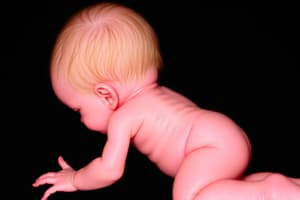Podcast
Questions and Answers
What is the prevalence of Meningomyelocele (MM)?
What is the prevalence of Meningomyelocele (MM)?
- 90%
- 50%
- 10%
- It varies among races and regions (correct)
When should folic acid supplements be taken to reduce the risk of Meningomyelocele (MM)?
When should folic acid supplements be taken to reduce the risk of Meningomyelocele (MM)?
- Begin during the second trimester
- Begin during the first trimester
- Begin 3 months before conception (correct)
- Begin during the third trimester
Which type of Myelodysplasia may or may not be skin covered and will cause paralysis?
Which type of Myelodysplasia may or may not be skin covered and will cause paralysis?
- Occulta
- Meningocele
- Myeloschisis
- Meningomyelocele (MM) (correct)
At what gestational age is Meningomyelocele (MM) typically diagnosed?
At what gestational age is Meningomyelocele (MM) typically diagnosed?
What is the recommended treatment for neurogenic bladder?
What is the recommended treatment for neurogenic bladder?
What is a potential consequence of S2 to S4 not functioning?
What is a potential consequence of S2 to S4 not functioning?
What is a key focus of physical therapy treatment?
What is a key focus of physical therapy treatment?
What is a potential indicator of successful bowel program?
What is a potential indicator of successful bowel program?
What assessment should be conducted for skin breakdown and obesity?
What assessment should be conducted for skin breakdown and obesity?
When is surgical fusion recommended for spinal deformities?
When is surgical fusion recommended for spinal deformities?
What is the goal of orthotic intervention using bivalve Silastic TLSO?
What is the goal of orthotic intervention using bivalve Silastic TLSO?
How often should standing programs be conducted to improve bone mineral density?
How often should standing programs be conducted to improve bone mineral density?
What is the purpose of in-utero repair of myelomeningocele (MM) during pregnancy?
What is the purpose of in-utero repair of myelomeningocele (MM) during pregnancy?
What do high level lesions (Thoracic to L2) of MM typically present with?
What do high level lesions (Thoracic to L2) of MM typically present with?
What is the purpose of the newest classification for children with MM?
What is the purpose of the newest classification for children with MM?
What is a common co-morbidity in children with MM, often requiring ventriculoperitoneal shunting?
What is a common co-morbidity in children with MM, often requiring ventriculoperitoneal shunting?
What does the motor level indicate in children with MM?
What does the motor level indicate in children with MM?
What is a common deformity in children with MM that can lead to hydrocephalus?
What is a common deformity in children with MM that can lead to hydrocephalus?
What is a possible complication associated with MM that may involve posterior fossa decompression?
What is a possible complication associated with MM that may involve posterior fossa decompression?
What is a common musculoskeletal deformity experienced by children with MM?
What is a common musculoskeletal deformity experienced by children with MM?
What do children with sacral lesions of MM may experience in terms of ambulation?
What do children with sacral lesions of MM may experience in terms of ambulation?
What do sensory deficits in children with MM often not correlate with?
What do sensory deficits in children with MM often not correlate with?
What is an additional complication associated with MM?
What is an additional complication associated with MM?
What is a common requirement for surgical management of Chiari II malformation?
What is a common requirement for surgical management of Chiari II malformation?
Study Notes
Management and Complications of Myelomeningocele (Spina Bifida)
- In-utero repair of myelomeningocele (MM) during pregnancy reduces the need for shunting and increases the likelihood of walking without devices.
- Children with MM often experience musculoskeletal deformities such as scoliosis, kyphosis, and hip dysplasia.
- Motor level indicates the lowest intact, functional neuromuscular segment and is used to classify the severity of MM.
- High level lesions (Thoracic to L2) typically present with hip and knee contractures, scoliosis, and require assistive devices for ambulation.
- The newest classification for children with MM includes parapodium and mid to low lumbar lesions, each with specific functional abilities and ambulation requirements.
- Children with sacral lesions may walk without orthoses or upper limb support, but may experience mild to moderate gait abnormalities.
- Sensory deficits in children with MM often do not correlate with motor level and may skip levels, necessitating comprehensive testing.
- Hydrocephalus is a common co-morbidity in children with MM, often requiring ventriculoperitoneal shunting to manage fluid accumulation in the brain.
- Chiari II malformation, a deformity of the cerebellum and spinal cord, is common in children with MM and can lead to hydrocephalus.
- Cognitive and language dysfunction, latex allergy, upper limb dyscoordination, spasticity, and seizures are additional complications associated with MM.
- Surgical management for Chiari II malformation may involve posterior fossa decompression and cervical spinal laminectomy to relieve pressure on the brainstem.
- Children with MM may experience a range of complications, including cognitive dysfunction, language dysfunction, latex allergy, and upper limb dyscoordination, among others.
Studying That Suits You
Use AI to generate personalized quizzes and flashcards to suit your learning preferences.



